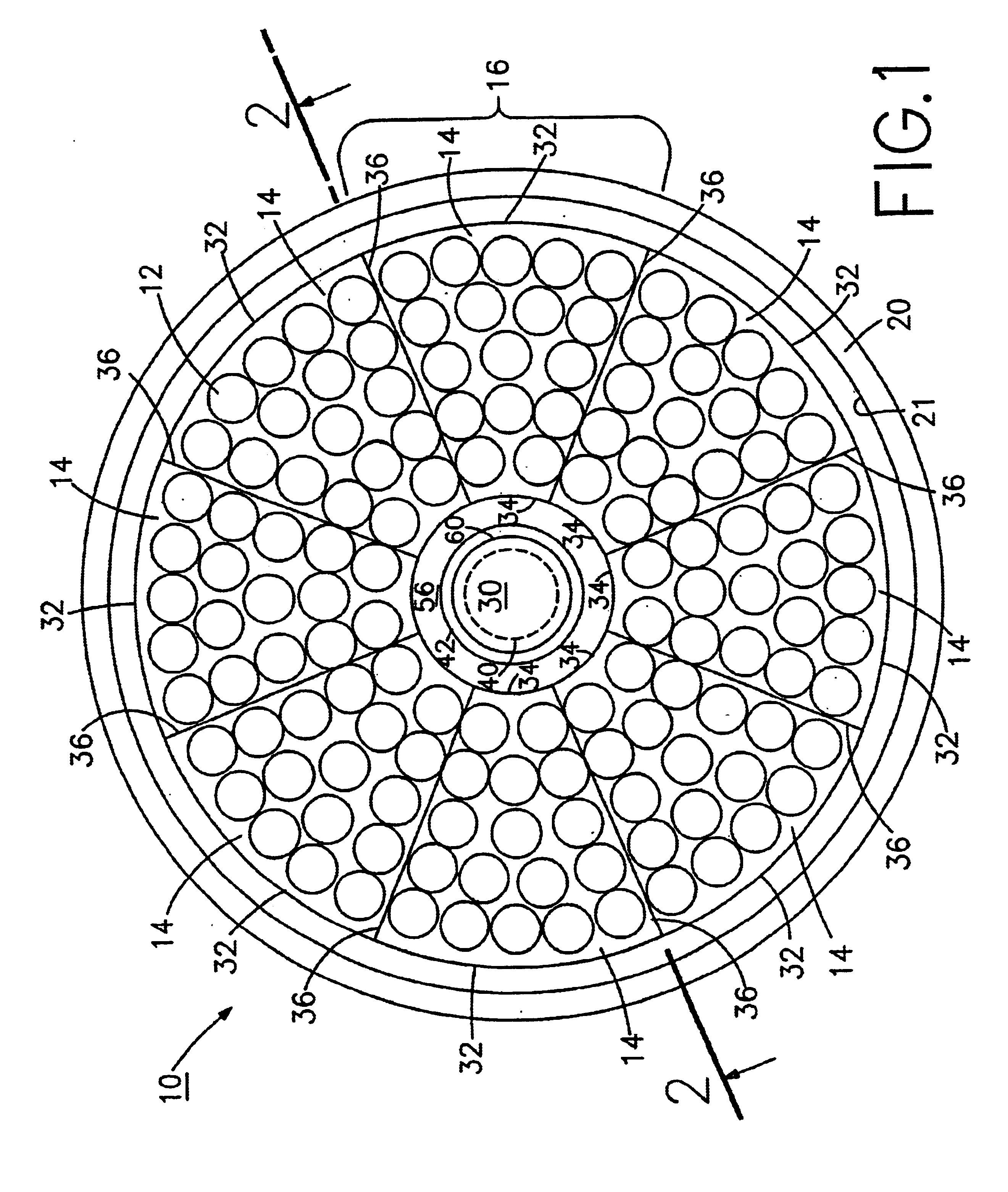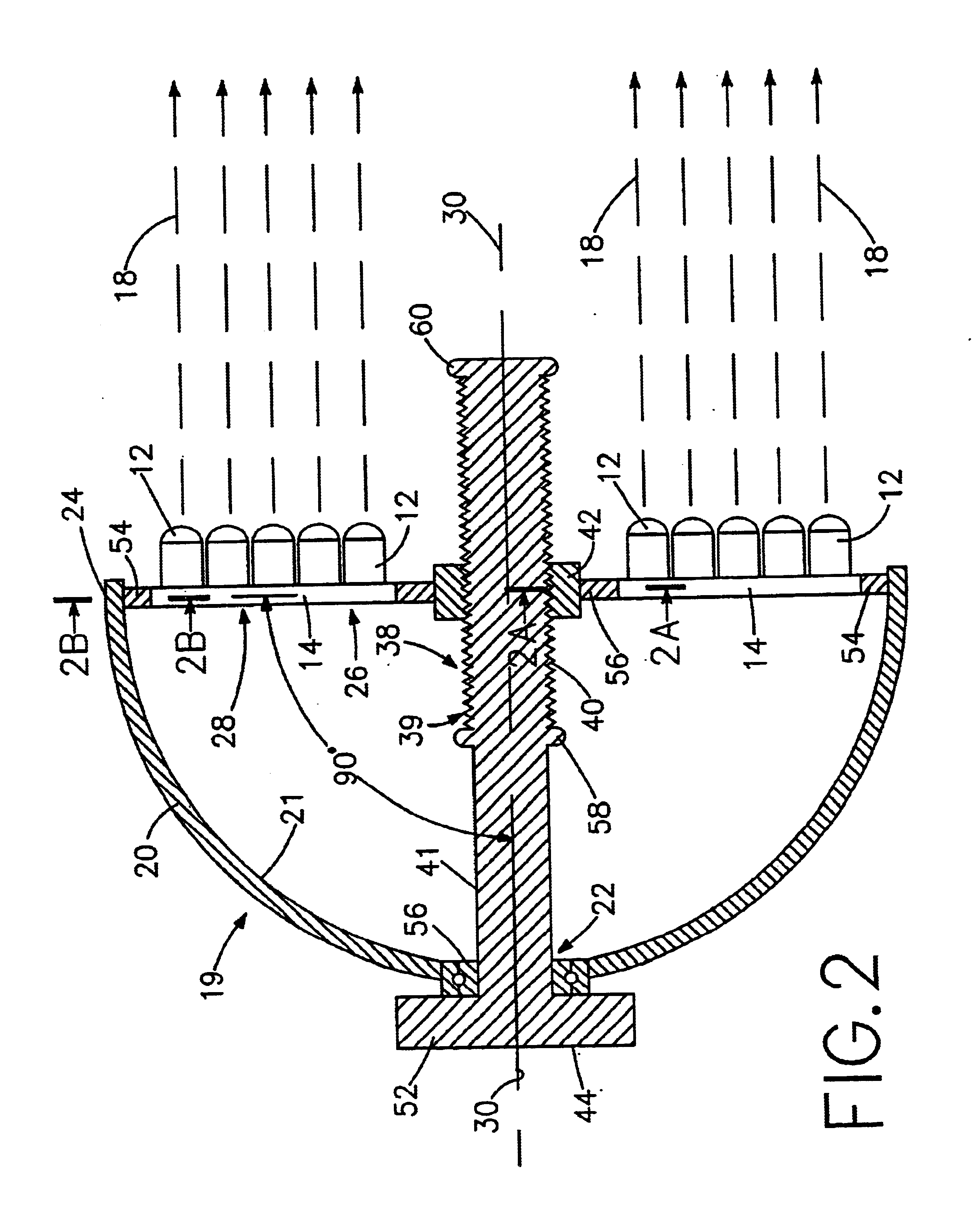Variable beam LED light source system
- Summary
- Abstract
- Description
- Claims
- Application Information
AI Technical Summary
Benefits of technology
Problems solved by technology
Method used
Image
Examples
embodiment 62
[0068]FIG. 6 shows a diode lighting system embodiment 62 generally analogous to diode lighting system 10 that includes housing 19 with the circular housing rim 24 defining circular aperture 26 and diodes 12 mounted to eight diode panels 14. Screw arrangement 38 including externally threaded solid cylinder 40 having opposed inner and outer end portions 44 and 46, respectively, and internally threaded cylindrical nut 42 threaded thereto is mounted in housing 19 at inner end portion 44 in alignment with a central housing axis 30. An optional handwheel 64 is positioned external to housing 19 at inner end portion 44. Eight diode panels 14 having diodes 12 mounted thereto are connected to housing 19 at circular housing rim 24 exactly as shown in FIGS. 1 and 2. Flexible internal and outer connecting rings 54 and 56, respectively, connect diode panels 14 to cylindrical nut 42 as shown in FIGS. 1 and 2. Internal and external stops 58 and 60, respectively, are mounted to externally threaded c...
embodiment 142
[0080]FIG. 12 shows a diode lighting system embodiment 142 generally analogous to diode lighting system 88 that includes housing 97 and housing wall 98 with housing rim 106 defining circular aperture 104 lying in a housing rim aperture plane 106 and seventeen diodes 90 mounted to eight diode panels 92. Externally threaded solid cylinder 119 and the center of housing circular aperture 104 are aligned with an axis 108. Screw arrangement 118 including externally threaded solid cylinder 119 having opposed inner and outer end portions 124 and 126, respectively, and internally threaded cylindrical nut 122 threaded thereto is mounted within housing 97 with inner end portion 124 in alignment with central housing axis 108. An optional handwheel 144 is positioned external to housing wall 98 at inner end portion 124. Eight diode panels 92 having diodes 90 mounted thereto are connected to housing 97 at circular rim 102 as shown in FIGS. 7, 8, 9, and 10. An internal cylindrical stop 138 is conne...
embodiment 198
[0103]Referring to FIGS. 19 and 20, these figures are similar to FIGS. 17 and 18, except that the luminaire 198′ is intended for interior use. Such an indoor luminaire may be similar to the indoor luminaire sold by Altman Stage Lighting Company under the trademark “STAR PAR”. It will be noted that the same flat rigid panels 14a-14f are contained within the housing 200′, a shorter clear lens cover 204′ being used to protect the LEDs on the interior and to prevent inadvertent injury to personnel that might result from exposure of the LEDs to touch. A conventional retainer support 228 may be used in conjunction with a holding clip or clamp 230 that may be used for supporting various optical components in front of the luminaire, such as color filters, gobos, etc. As in the embodiment 198 shown in FIGS. 17 and 18, a cable 212 is connected to the unit for introducing power and / or digital signals for controlling the colors of the LEDs.
[0104]Referring to FIG. 21, an overall lighting system ...
PUM
 Login to View More
Login to View More Abstract
Description
Claims
Application Information
 Login to View More
Login to View More - R&D
- Intellectual Property
- Life Sciences
- Materials
- Tech Scout
- Unparalleled Data Quality
- Higher Quality Content
- 60% Fewer Hallucinations
Browse by: Latest US Patents, China's latest patents, Technical Efficacy Thesaurus, Application Domain, Technology Topic, Popular Technical Reports.
© 2025 PatSnap. All rights reserved.Legal|Privacy policy|Modern Slavery Act Transparency Statement|Sitemap|About US| Contact US: help@patsnap.com



